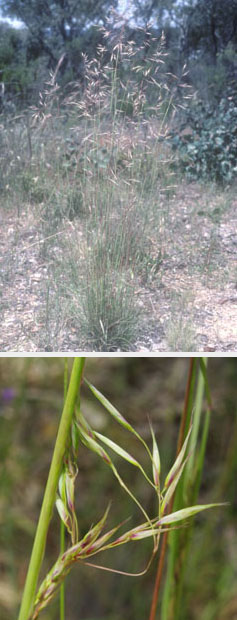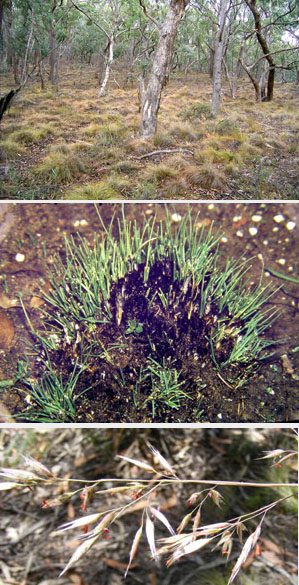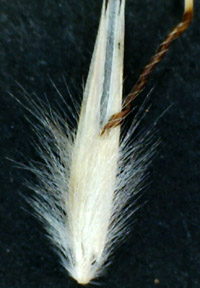Red-anther Wallaby-grass - native (Rytidosperma pallidum)



Native. Perennial. C3.
Family. Poaceae (Grass family).
Alternative names: Chionochloa pallida, Joycea pallida, Silver-top Wallaby-grass.
Occurrence: Red-anther Wallaby-grass is very common and abundant in local forests. It may cover most of the forest floor.
Identification:
- the flowers form a compact cluster
- the glumes are longer than the lemmas
- the lemmas are forked into two lobes with an awn rising bewteen the lobes
- the backs of the lemmas have a uniform cover of hairs.
- the leaves are closely rolled
- the ligules are a dense row of hairs 0.5mm long.
It is a distinctive grass. The flower stalks are tall, to over 1.5m. The anthers are orange-red and very conspicuous when the grass is flowering. The lemmas have fine silky hairs covering the back of the lemmas (not in rows as in most other wallaby grasses). It forms tussocks to half a metre across.
Red-anther Wallaby-grass often grows with Grey Tussock-grass (Poa sieberiana). Grey Tussock-grass usually has smaller tussocks, the flowers are on much shorter stalks and the spikelets much smaller and unawned. When not in flower, the two grasses can be distinguished by the ligules: Wallaby Grass has a dense row of short hairs, and poa a firm squared-off membrane).
pallida: pale.
Left 1: The lemma back is covered with fine hairs. Centre 2: Red-anther Wallaby-grass tussocks. Porcupine Ridge Road.
Centre 3: Regeneration after fire. Eureka Diggings. Reshooting is not assured and many fail to reshoot after a fire, particularly in drought conditions. Kalimna Reserve.
Centre 4: The orange-red anthers are a conspicuous feature.
Right 5: The flower stalks are well over a metre long. Right 6: Freshly opened flower cluster.